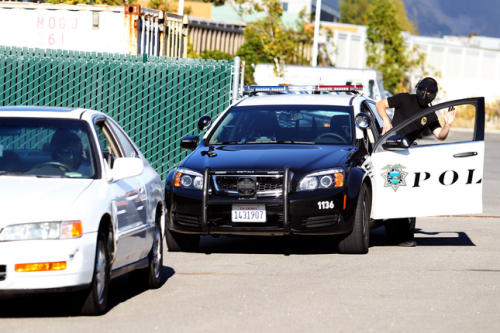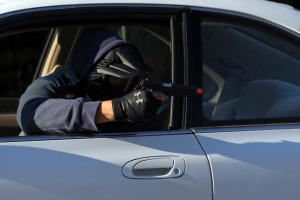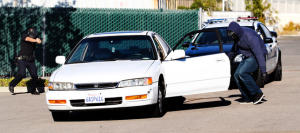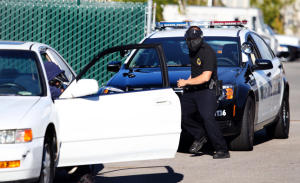| |
Use of deadly force by police disappears on Richmond streets
By Robert Rogers and David DeBolt Contra Costa Times
Posted: 09/06/2014 05:03:28 PM PDT0 Comments | Updated: 91 min. ago

Richmond police officer Michael Brown, right, and detective Mauricio Canelo participate in a car stop exercise where Brown and Canelo, as the civilian driver, shoot at each other with air pistols at the Richmond Police Department headquarters in Richmond, Calif., on Friday, Aug. 22, 2014. (Ray Chavez/Bay Area News Group)
RICHMOND -- Two cops sprinted up the stairs of a ramshackle downtown apartment building, then set eyes on two men at the end of a narrow hall.
Officer Matt Stonebraker rushed in first, scuffling briefly with one man while the other raised his hands in surrender. Moments later, after a whirlwind of thrashing limbs, the suspect was cuffed and choked up a golf ball-sized plastic bag of rock cocaine.
In this 2011 episode, the police officers ¿never unholstered their guns.

Richmond Police Department detective Mauricio Canelo left, as a civilian driver, shoots at Richmond police officer Enrik Melgoza with an air pistol during a car stop exercise at the Richmond Police Department headquarters in Richmond, Calif., on Friday, Aug. 22, 2014. (Ray Chavez/Bay Area News Group)
A spate of high-profile police shootings nationwide, most notably the killing of a black teen in Ferguson, Missouri, has stoked intense scrutiny of deadly force by officers and driven a series of demonstrations across the nation and the Bay Area. But in Richmond, historically one of the most violent cities in the Bay Area, the Police Department has averaged fewer than one officer-involved shooting per year since 2008, and no one has been killed by a cop since 2007.
That track record stands in sharp contrast to many other law enforcement agencies in the region, according to a review of data compiled from individual departments.
Advertisement
Many observers and police officials attribute Richmond's relatively low rate of deadly force to reforms initiated under Chief Chris Magnus, who took over a troubled department in this city of 106,000 in 2006. Magnus implemented a variety of programs to reduce the use of lethal force, including special training courses, improved staffing deployments to crisis situations, thorough reviews of all uses of force and equipping officers with nonlethal weapons such as Tasers and pepper spray.

Richmond police officer Michael Brown, left, and detective Mauricio Canelo participate in a car stop exercise where Brown and Canelo, as the civilian driver, shoot at each other with air pistols at the Richmond Police Department headquarters in Richmond, Calif., on Friday, Aug. 22, 2014. (Ray Chavez/Bay Area News Group)
"Our officers are used to dealing with individuals who are dangerous and, often, armed," Magnus said. "It's not an aberration -- the scary and challenging is routine -- and I think that gives them the familiarity to know what level of force to apply."
In Oakland, population 400,000, 33 people were shot by police from 2008 to 2013, 20 of them fatally. In San Pablo, which borders Richmond but is less than one-third its size, four people were shot by police, two fatally.
In the jurisdiction of cities and unincorporated areas that hire the Contra Costa Sheriff's Office to patrol their streets, deputies shot and killed nine people and wounded six others during that period. Antioch had seven fatal shootings, and six people were wounded by officers. Concord police shot two people dead, and five total.

Richmond police officer Michael Brown, right, and detective Mauricio Canelo participate in a car stop exercise where Brown and Canelo, as the civilian driver, shoot at each other with air pistols at the Richmond Police Department headquarters in Richmond, Calif., on Friday, Aug. 22, 2014. (Ray Chavez/Bay Area News Group)
Perhaps most striking, while Richmond police have not killed anyone, other agencies have shot four suspects, killing two, while working special operations in the city since 2008. While anecdotes of suspects dying in a hail of police gunfire have been reported across the country -- the teen in Ferguson was struck six times -- the four people shot by Richmond police since 2008 were hit with a total of five bullets, and all survived.
"In training, we stress accuracy and accountability," said Lt. Louie Tirona, Richmond's lead firearms and tactics instructor. "We tell our cops from the get-go, 'Every bullet has your name on it.'"
Magnus emphasizes that policing walks a fine line between restraint and safety for the officers and the community.
"Some of this is a little bit of luck," Magnus said. "There are times when deadly force is the only choice."
More important than luck, said law enforcement expert Tom Nolan, is the culture within a department. If a chief has sent a clear message that instances of deadly force will be scrutinized, you can expect more officers to think twice before firing a weapon, or employ less-lethal means when apprehending a suspect, he said.
"The chief is key in setting policy and tone," said Nolan, who worked for 27 years as a cop in Boston and now directs graduate programs in criminology at Merrimack College in Massachusetts. "If they haven't had an officer-involved shooting that's resulted in death in a city like that, it's commendable."
Christopher Boyd, president of the California Police Chiefs Association, said a range of factors determines whether officers must use deadly force and that most of them lie with the behavior of the people being shot. But, Boyd said, the question of culture and leadership in a given department is an important one.
"Yes, department leadership culture plays a role in use of force," Boyd said. "It's a factor in setting policy, implementing cutting-edge training and establishing tone and culture. But I must be clear that just because a community has its share of officer-involved shootings does not mean there is poor leadership."
While police across jurisdictions have fairly uniform policies enabling them to use force when they deem there is a risk to themselves or the public, Tirona says the difference in Richmond includes the rigor of training, the emphasis on communication with armed suspects, the thorough review of all force used and the philosophy that force must only be a last resort.
Richmond officers undergo firearm training monthly and role-playing scenarios for disarming suspects four times a year, a higher average than many other departments, Nolan said. The role-playing exercises, in which officers bark commands while holding their guns and make split-second decisions when confronted by armed residents, began in 2008, the same time that officer-involved shootings in the department plummeted. Richmond cops shot five people, one fatally, in 2006-07.
Since then, violent crime in the city has plunged, no officers have been shot, and no suspects have been killed by officers' bullets.
Magnus has done something in Richmond that he believes is not done enough in other departments: He's been willing to second-guess the deadly force used by other cops.
"We use a case study approach to different incidents that happen in different places. When there is a questionable use-of-force incident somewhere else, we study it and have a lot of dialogue," Magnus said. "It's a model that is used in a range of other professions, but in some police circles, it's seen as judging in hindsight and frowned on. In my mind, that attitude is counterproductive."
Richmond's robust police force has also enabled Magnus to implement programs and training that are difficult, if not impossible, to replicate in departments that have been ravaged by budget cuts. In Antioch, roughly the same size as Richmond, the Police Department is down to 90 officers, less than half of Richmond's, from a high of 126 in 2007, said Capt. Leonard Orman. Use-of-force training was at the state minimum of once per year until recently, he said.
Still, Orman said there was no evidence that any of the seven fatal officer-involved shootings in the city since 2008 resulted from low staffing or less training. "They were all good shoots," Orman said.
In Concord, officers train on the use of force twice a year, and an in-house committee reviews all instances of force, including deadly force, said Sgt. John Nunes, who oversees the department's training courses. Nunes said no department is immune from potential deadly force scenarios.
"We give officers a spectrum of tools, but if it's going to happen, it's going to happen," Nunes said. "But nobody wants it to happen."
Richmond police Lt. Shawn Pickett says Magnus changed the department from one that focused on "impact teams" of officers who roamed rough neighborhoods looking to make arrests to one that required all officers to adopt a "community policing" model, which emphasizes relationship building.
"We had generations of families raised to hate and fear the Richmond police, and a lot of that was the result of our style of policing in the past," Pickett said. "It took us a long time to turn that around, and we're seeing the fruits of that now. There is a mutual respect now, and some mutual compassion."
Contact Robert Rogers at rrogers@bayareanewsgroup.com and David DeBolt at ddebolt@bayareanewsgroup.com
|
|

